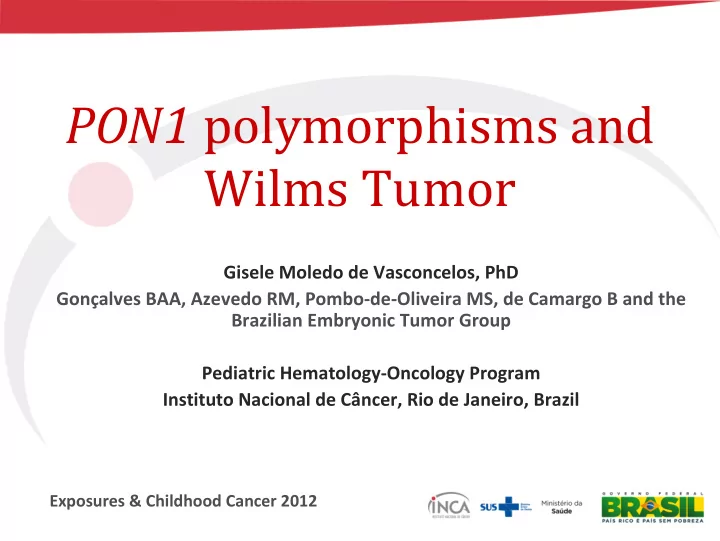

PON1 polymorphisms and Wilms Tumor Gisele Moledo de Vasconcelos, PhD Gonçalves BAA, Azevedo RM, Pombo ‐ de ‐ Oliveira MS, de Camargo B and the Brazilian Embryonic Tumor Group Pediatric Hematology ‐ Oncology Program Instituto Nacional de Câncer, Rio de Janeiro, Brazil Exposures & Childhood Cancer 2012
Wilms tumor Wilms tumor Fetal kidney 18 weeks Mature kidney
Pesticides and Wilms Tumor • Previous studies have shown an association of pesticides exposures and Wilms Tumor risk .
Pesticides and Wilms Tumor
Paraoxonase 1 (PON1) • Hydrolyses active metabolites of organophosphorus pesticides. • Levels of PON1 change according to age. • And also due to polymorphims.
Polymorphisms in the gene PON1 PON1 Q192R – change activity PONL55M – change enzyme levels Children susceptibility to Wilms Tumor can be modified by PON1 genotypes: # their own genotype # and during pregnancy, in case of exposition, maternal genotype
Aims • Identify the distribution of PON1 (Q192R and L55M) polymorphisms and its relationship with Wilms tumor & embryonal neuroectodermal origin tumors development in Brazilian children. • Identify the frequencies of PON1 polymorphisms in mothers and the occurrence of embryonic tumors in their children.
Subjects and Methods • Allelic discrimination (TaqMAN • 47 Brazilian children with WT probes) and their mothers; • 49 other embryonal tumors (retinoblastoma, neuroblastoma and medulloblastoma) and their mothers; • 190 health children and 117 mothers
Subjects and Methods • Wilms Tumor patients: age ranged from 0 – 125 months. • Other embryonal tumors: age range from 0 – 132 months. • Children used as controls: age range from 0 – 60 months. • There was no statistical difference according to gender in tumors nor even in controls.
Results
• Mothers genotypes and children genotypes together: • PON1 Q192R – QQ/QQ; QQ/QR; QR/QQ; QR/QR; RR/QR; RR/RR • PON L55M – LL/LL; LL/LM; LM/LL; LM/MM; MM/LM; MM/MM • We observed no significant differences but N is too small.
Final Remark • Despite the small series of cases , our preliminary results suggest that PON1 Q192R polymorphism may be an important risk factor in the development of WT when children are exposed to pesticides.
Acknowledgements • Ministério da Saúde • Support Agencies • Pediatric Hematology ‐ Oncology Program • Brazilian Embryonic tumor group • Dra. Maria do Socorro Pombo ‐ de ‐ Oliveira & Dra. Beatriz de Camargo • Rafaela Montalvão & Bruno A. Gonçalves
THANK YOU!
Recommend
More recommend